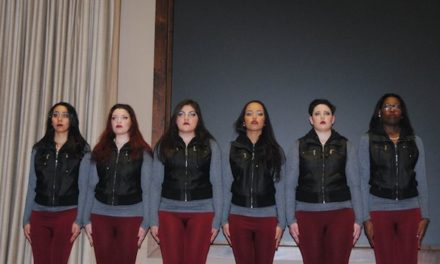Emory alumnus John Herbers (49C), a former New York Times correspondent who embarked on a near 40-year career of profiling civil rights greats and detailing government scandals following his time at Emory, died March 17 in his Washington, D.C., retirement home of causes linked to degenerative brain disease, according to his daughter, Anne Farris Rosen. He was 93 years old.
Born Nov. 4, 1923, in Memphis, Tenn., Herbers became one of the first journalists to “get down the civil rights story,” said Paul Hendrickson, who considered Herbers a mentor. Herbers wore myriad hats, including justice guru, American norms critic and Pulitzer Prize finalist.
Herbers was also a WWII vet who studied journalism at Emory under the G.I. Bill of Rights. He worked on The Emory Wheel and embraced starkly liberal ideas, said his daughter Mary Herbers, which contrasted those characteristic of his upbringing in a traditional family with a racist vernacular.
After landing his first journalism stint with The Greenwood Star in Mississippi, he booked jobs with The Jackson Daily News, The New York Times and more, including one with the White House as Watergate unfolded.
Herbers’ daughters remember their father’s commitment to advancing civil rights through storytelling. While he rarely took his stories home, Herbers sometimes brought his daughters on gigs, including to a Klu Klux Klan rally.
“It was an incredible upbringing,” said Rosen, who became a journalist herself. “It wasn’t focused on us. It was focused on this larger world of politics and change.”
After retiring from the New York Times in 1987, a “huge loss” for him, said Mary Herbers, her father transitioned to a life of freelancing and teaching at Princeton University. “Boy,” he would say, “it’s great teaching at a place you could never get into.”
Yet Herbers had made his way to countless places, letting on little apprehension. Dubbed the “Forrest Gump of journalism” by his family, Herbers frequented landmark events of the civil rights movement, Rosen said.
“He was in Selma; he was in Birmingham … he was in the kitchen of the Ambassador Hotel when Bobby Kennedy was shot.” And, she added, he saw the body.
Herbers was also in St. Augustine, Fla., when Martin Luther King Jr. refused to budge from a lunch counter, Slate said. Herbers brought his family along for the trip — his wife, Betty, had wanted a beach day — but they wound up a target of the journalist-terrorizing Manucy Raiders who tried everything to “scare Dad out of town.”
When one of the Raiders pulled a rifle in front of Herbers’ hotel room door, he immediately drove his family to safety in Atlanta, Slate recalled. Then, he headed back to Florida. It took cars full of violent white men and sedentary police officers to force Herbers out of St. Augustine for a second time. Slate said that as he was leaving, Herbers heard on his car radio, “We got rid of another one of those son-of-a-bitch reporters.”
Despite the rampant terror in the South, Slate said, “He didn’t want to hide from us what was happening.”
Although Herbers boarded Air Force One to report on former U.S. presidents Richard Nixon and Gerald Ford, and chatted with Malcolm X, his work was not always glorious. He also labored over U.S. Census reports and meticulously edited colleagues’ stories.
Even so, Herbers lost himself in his work. He covered the 1955 Emmett Till trial during one sweaty September, Slate said. He scrambled from a segregated courtroom to payphone areas swarming with hungry reporters. When the Till verdict was read and the two white men were acquitted, he walked across the street and ordered a beer.
On the night of the 1963 Sixteenth Street Baptist Church bombing in Birmingham, Ala., Herbers went to the four homes of the girls who were killed and interviewed their parents, Rosen recalled.
In his memoir, scheduled to be published next year, Herbers recounts the moment he learned about the bombing via his rental car radio. The same journalistic drive that once led him back to St. Augustine consumed Herbers: “I pulled a sharp U-turn and headed back downtown [to report],” he wrote in the untitled memoir.
That same year, Herbers met Bill Kovach, who would become a New York Times colleague and lifelong friend. “John [defeated the competition] without upsetting anybody, even the people he beat,” Kovach said.
Herbers always got the story, Kovach said, with a cut-in-half notebook hidden in his hip pocket. “He covered it deeper; he covered it better; he covered it more carefully and he won the race.”
Hendrickson added that Herbers always granted his subjects humanity. During an early encounter, Hendrickson showed Herbers a Life Magazine photograph depicting the James Meredith narrative, in which seven sheriffs worked hand over fist to prevent a black student’s attendance at Ole Miss.
Herbers spread the photograph on his knees and shook his head. “He said, ‘these are our people,’” Hendrickson recalled. “He didn’t condemn them. He understood them.”
While Herbers might have been gone on a story for five to six weeks at a time, his daughters said he made time to teach them good values and to bask in their company when possible.
He also made abundant time for his wife Betty, who died six weeks before him.
“[My mom] thought [Herbers] could be president, and don’t we wish she could have been right,” Slate said.
emily.sullivan@emory.edu | Emily Sullivan (18C) is from Blue Bell, Pa., majoring in international studies and minoring in ethics. She served most recently as news editor. Last summer, she interned with Atlanta Magazine. Emily dances whenever she can and is interested in the relationship between journalism and human rights issues.





